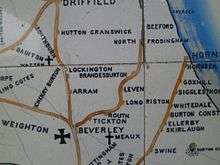North Holderness Light Railway
Coordinates: 53°57′47″N 0°19′48″W / 53.963°N 0.330°W
| North Holderness Light Railway (Never constructed) | |||||||||||||||||||||||||||||||||||||||||||||||||||||||||||||
|---|---|---|---|---|---|---|---|---|---|---|---|---|---|---|---|---|---|---|---|---|---|---|---|---|---|---|---|---|---|---|---|---|---|---|---|---|---|---|---|---|---|---|---|---|---|---|---|---|---|---|---|---|---|---|---|---|---|---|---|---|---|
| |||||||||||||||||||||||||||||||||||||||||||||||||||||||||||||
The North Holderness Light Railway was a proposed light railway, which was to have been constructed between Beverley and North Frodingham, in the East Riding of Yorkshire, England. The scheme was abandoned in 1903 by the North Eastern Railway (NER) and replaced with a bus service.[1]
The line would have begun from a junction with the Hull to Scarborough Line, slightly to the north of Beverley railway station, and served villages and agricultural land in the Holderness area. Stations were proposed at Tickton, Routh, Long Riston, Leven, Brandesburton and North Frodingham.
The route can be seen on tiled maps of the North Eastern Railway network[2] still extant at:
- Beverley railway station
- Hartlepool railway station
- Middlesbrough railway station
- Morpeth railway station
- National Railway Museum (York)
- Pickering railway station (Modern reproduction)
- Saltburn railway station
- Scarborough railway station
- Tynemouth Metro station
- Whitby railway station
- York railway station

Tile map showing the route
References
- ↑ Young, Alan (2015). Lost stations of Yorkshire - the West Riding. Kettering: Silverlink. pp. 7–8. ISBN 978-1-85794-438-9. Retrieved 19 December 2015.
- ↑ "A Bit Of History". North Eastern Tile Company Ltd. Retrieved 21 August 2009.
Further reading
- Limon, Martin (November 2006). Tales From the East Riding. Tempus Publishing. ISBN 0-7524-4038-1.
This article is issued from
Wikipedia.
The text is licensed under Creative Commons - Attribution - Sharealike.
Additional terms may apply for the media files.
